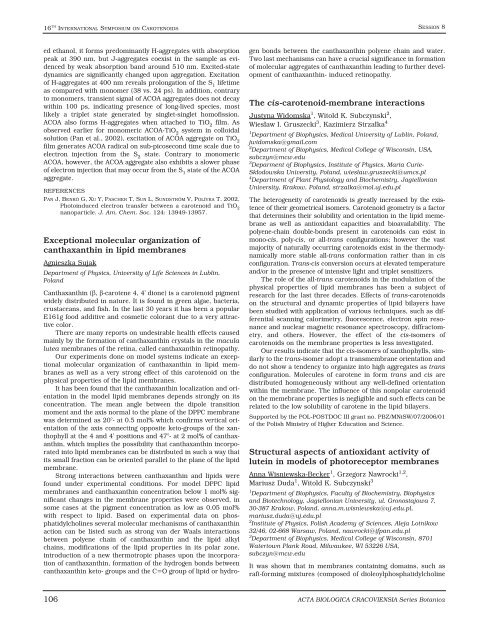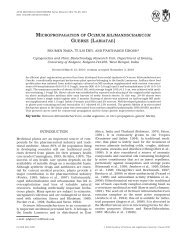ACTA BIOLOGICA CRACOVIENSIA
ACTA BIOLOGICA CRACOVIENSIA
ACTA BIOLOGICA CRACOVIENSIA
Create successful ePaper yourself
Turn your PDF publications into a flip-book with our unique Google optimized e-Paper software.
16 TH INTERNATIONAL SYMPOSIUM ON CAROTENOIDS<br />
ed ethanol, it forms predominantly H-aggregates with absorption<br />
peak at 390 nm, but J-aggregates coexist in the sample as evidenced<br />
by weak absorption band around 510 nm. Excited-state<br />
dynamics are significantly changed upon aggregation. Excitation<br />
of H-aggregates at 400 nm reveals prolongation of the S 1 lifetime<br />
as compared with monomer (38 vs. 24 ps). In addition, contrary<br />
to monomers, transient signal of ACOA aggregates does not decay<br />
within 100 ps, indicating presence of long-lived species, most<br />
likely a triplet state generated by singlet-singlet homofission.<br />
ACOA also forms H-aggregates when attached to TiO 2 film. As<br />
observed earlier for monomeric ACOA-TiO 2 system in colloidal<br />
solution (Pan et al., 2002), excitation of ACOA aggregate on TiO 2<br />
film generates ACOA radical on sub-picosecond time scale due to<br />
electron injection from the S 2 state. Contrary to monomeric<br />
ACOA, however, the ACOA aggregate also exhibits a slower phase<br />
of electron injection that may occur from the S 1 state of the ACOA<br />
aggregate.<br />
REFERENCES<br />
PAN J, BENKÖ G, XU Y, PASCHER T, SUN L, SUNDSTRÖM V, POLÍVKA T. 2002.<br />
Photoinduced electron transfer between a carotenoid and TiO2 nanoparticle. J. Am. Chem. Soc. 124: 13949-13957.<br />
Exceptional molecular organization of<br />
canthaxanthin in lipid membranes<br />
Agnieszka Sujak<br />
Department of Physics, University of Life Sciences in Lublin,<br />
Poland<br />
Canthaxanthin (β, β-carotene 4, 4' dione) is a carotenoid pigment<br />
widely distributed in nature. It is found in green algae, bacteria,<br />
crustaceans, and fish. In the last 30 years it has been a popular<br />
E161g food additive and cosmetic colorant due to a very attractive<br />
color.<br />
There are many reports on undesirable health effects caused<br />
mainly by the formation of canthaxanthin crystals in the macula<br />
lutea membranes of the retina, called canthaxanthin retinopathy.<br />
Our experiments done on model systems indicate an exceptional<br />
molecular organization of canthaxanthin in lipid membranes<br />
as well as a very strong effect of this carotenoid on the<br />
physical properties of the lipid membranes.<br />
It has been found that the canthaxanthin localization and orientation<br />
in the model lipid membranes depends strongly on its<br />
concentration. The mean angle between the dipole transition<br />
moment and the axis normal to the plane of the DPPC membrane<br />
was determined as 20°- at 0.5 mol% which confirms vertical orientation<br />
of the axis connecting opposite keto-groups of the xanthophyll<br />
at the 4 and 4' positions and 47°- at 2 mol% of canthaxanthin,<br />
which implies the possibility that canthaxanthin incorporated<br />
into lipid membranes can be distributed in such a way that<br />
its small fraction can be oriented parallel to the plane of the lipid<br />
membrane.<br />
Strong interactions between canthaxanthin and lipids were<br />
found under experimental conditions. For model DPPC lipid<br />
membranes and canthaxanthin concentration below 1 mol% significant<br />
changes in the membrane properties were observed, in<br />
some cases at the pigment concentration as low as 0.05 mol%<br />
with respect to lipid. Based on experimental data on phosphatidylcholines<br />
several molecular mechanisms of canthaxanthin<br />
action can be listed such as strong van der Waals interactions<br />
between polyene chain of canthaxanthin and the lipid alkyl<br />
chains, modifications of the lipid properties in its polar zone,<br />
introduction of a new thermotropic phases upon the incorporation<br />
of canthaxanthin, formation of the hydrogen bonds between<br />
canthaxanthin keto- groups and the C=O group of lipid or hydro-<br />
gen bonds between the canthaxanthin polyene chain and water.<br />
Two last mechanisms can have a crucial significance in formation<br />
of molecular aggregates of canthaxanthin leading to further development<br />
of canthaxanthin- induced retinopathy.<br />
The cis-carotenoid-membrane interactions<br />
SESSION 8<br />
Justyna Widomska 1 , Witold K. Subczynski 2 ,<br />
Wiesław I. Gruszecki 3 , Kazimierz Strzałka 4<br />
1Department of Biophysics, Medical University of Lublin, Poland,<br />
jwidomska@gmail.com<br />
2Department of Biophysics, Medical College of Wisconsin, USA,<br />
subczyn@mcw.edu<br />
3Deparment of Biophysics, Institute of Physics, Maria Curie-<br />
Skłodowska University, Poland, wieslaw.gruszecki@umcs.pl<br />
4Department of Plant Physiology and Biochemistry, Jagiellonian<br />
University, Krakow, Poland, strzalka@mol.uj.edu.pl<br />
The heterogeneity of carotenoids is greatly increased by the existence<br />
of their geometrical isomers. Carotenoid geometry is a factor<br />
that determines their solubility and orientation in the lipid memebrane<br />
as well as antioxidant capacities and bioavailability. The<br />
polyene-chain double-bonds present in carotenoids can exist in<br />
mono-cis, poly-cis, or all-trans configurations; however the vast<br />
majority of naturally occurring carotenoids exist in the thermodynamically<br />
more stable all-trans conformation rather than in cis<br />
configuration. Trans-cis conversion occurs at elevated temperature<br />
and/or in the presence of intensive light and triplet sensitizers.<br />
The role of the all-trans carotenoids in the modulation of the<br />
physical properties of lipid membranes has been a subject of<br />
research for the last three decades. Effects of trans-carotenoids<br />
on the structural and dynamic properties of lipid bilayers have<br />
been studied with application of various techniques, such as differential<br />
scanning calorimetry, fluorescence, electron spin resonance<br />
and nuclear magnetic resonance spectroscopy, diffractometry,<br />
and others. However, the effect of the cis-isomers of<br />
carotenoids on the membrane properties is less investigated.<br />
Our results indicate that the cis-isomers of xanthophylls, similarly<br />
to the trans-isomer adopt a transmembrane orientation and<br />
do not show a tendency to organize into high aggregates as trans<br />
configuration. Molecules of carotene in form trans and cis are<br />
distributed homogeneously without any well-defined orientation<br />
within the membrane. The influence of this nonpolar carotenoid<br />
on the memebrane properties is negligible and such effects can be<br />
related to the low solubility of carotene in the lipid bilayers.<br />
Supported by the POL-POSTDOC III grant no. PBZ/MNiSW/07/2006/01<br />
of the Polish Ministry of Higher Education and Science.<br />
Structural aspects of antioxidant activity of<br />
lutein in models of photoreceptor membranes<br />
Anna Wisniewska-Becker1 , Grzegorz Nawrocki1,2 ,<br />
Mariusz Duda1 , Witold K. Subczynski3 1 Department of Biophysics, Faculty of Biochemistry, Biophysics<br />
and Biotechnology, Jagiellonian University, ul. Gronostajowa 7,<br />
30-387 Krakow, Poland, anna.m.wisniewska@uj.edu.pl,<br />
mariusz.duda@uj.edu.pl<br />
2 Institute of Physics, Polish Academy of Sciences, Aleja Lotnikow<br />
32/46, 02-668 Warsaw, Poland, nawrocki@ifpan.edu.pl<br />
3 Department of Biophysics, Medical College of Wisconsin, 8701<br />
Watertown Plank Road, Milwaukee, WI 53226 USA,<br />
subczyn@mcw.edu<br />
It was shown that in membranes containing domains, such as<br />
raft-forming mixtures (composed of dioleoylphosphatidylcholine<br />
106 <strong>ACTA</strong> <strong>BIOLOGICA</strong> <strong>CRACOVIENSIA</strong> Series Botanica












